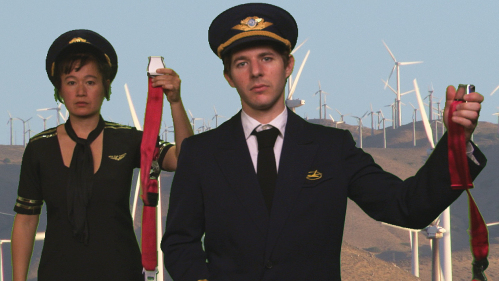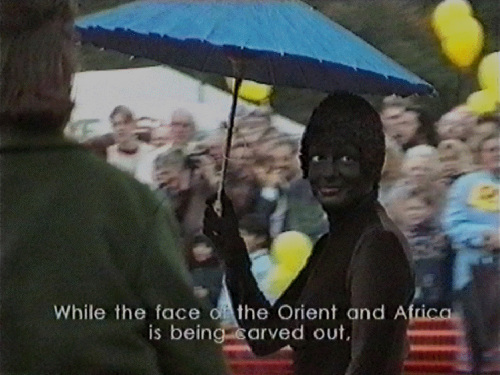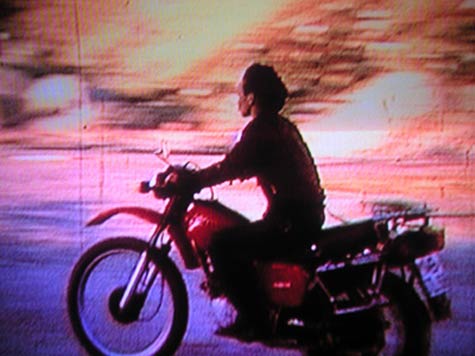Plane Destructive: the Recent Films of Hito Steyerl
With her latest film, In Free Fall, Hito Steyerl shifts her focus from the production and circulation of images to the consumption of objects. What political potential is released, asks Kerstin Stakemeier, when we understand consumption and destruction as a collectivising activity?
The popularity of the documentary form, in video, film and photography, has been widely debated in the realm of art over the last decade. Within the field of contemporary art, as a branch of the capitalist culture industry, the framing and production of subjects through the documentary form has come to carry an often dubious function. The figures of documentarism thereby produced offer a purely visual ‘engagement', providing spectators with images that 'should be seen', and repeating art's traditionally affirmative social function by replacing a political act with its visual representation.

Image: Still from Hito Steyerl's In Free Fall, 2010
Ever since the anti-G8 protests in Seattle (1999) and Genoa (2001) gave rise to what came to be labelled the ‘multitude', the documentary has come to provide the representational form for a set of associated visual-political affects. Due to the political as well as visual heterogeneity of 'the multitude', its visual representations provided role models or figures of identification, which, especially within the field of art, tend to depict political engagement as a kind of individual self-realisation. 'Documentarism' (a term coined by film-maker Hito Steyerl) in the visual codes of art has, both willingly and unwillingly, identified contemporary forms of political commitment as the fleeting spectacle of liberated individualism. Either that or as the romanticised and thus de-politicised glorification of a disobeying youth. In his contribution to The Greenroom, a volume 'reconsidering the documentary and contemporary art', published by Hito Steyerl and Maria Lind in 2008, Maurizio Lazzarato characterises the political radicality of Seattle as being an event that 'turns away from historical conditions in order to create something new.'1 This political appraisal of the 'event', as the moment of exception, has become popular not only through the philosophy of Alain Badiou but also due to the the recent proliferation of locally emerging and violent uprisings grasped in terms of the event by texts such as The Coming Insurrection. This motif provides a politically invaluable figure of radical negation and its ambivalences, but when simply transferred into the realm of contemporary art, is positivised aesthetically and thus evaporates into thin air.2 In art, where the event is the classical figure of art's sensationalism, of its epiphanic character, such fetishisations of a moment of truth serve an inverted function. In its aestheticisation, the singularised event bears no consequences, but releases a whiff of freedom beyond reality, an aesthetic norm of excess. As Steyerl puts it in her own contribution to the volume in which she discusses the 'coarse and blurry images' of contemporary documentarism: 'these images create the norm by reporting the exceptional, even unimaginable; they transform the exception into the rule.'3
This exceptionalism cultivated in art documentarism has largely helped give rise to the newly acclaimed genre of ‘political art' in the very same decade and which, today, is prominently displayed as another genre in the most influential institutions of contemporary art in Europe. Via projects like The Greenroom, which comprises a number of publications and exhibitions, it has even extended to the US. Meanwhile, the justificatory function of this kind of imagery has accompanied the export of Biennials into the global backyards of capitalist production while the exoticised imagery of these regions is imported back into the western showrooms of the self-same system. For the artistic reproduction of this imported imagery, this poses multiple problems, since it not only stages a scenario in which the ideological function of such imagery has to be complicated within the work and its production, but also one in which this might be rendered obsolete by its ‘successful' representation. As Steyerl argues in the same essay, documentarism in contemporary art only counteracts this spectacular and ultimately affirmative function where the terms of contemporary imagery's production are considered in relation to the drastic historical changes they have undergone within the last decades. Such changes cast into question their identity as art as much as the recent glorifications of their ever more mobile and digital means.
As a film-maker, teacher, writer and a public intellectual, Hito Steyerl has engaged intensively in the rise of 'documentarism in the field of art', which also is the subtitle of her book The Colour of Truth, published in German in 2008.4 Within the European art world, Steyerl has recently become one of the most prominent agents of a critical artistic position in film, proposing a documentarism of (rather than in) her own medium, and its critique through video, TV and web imagery. Through her multiple interventions, also as a writer, Steyerl has made a strong case for the 'defense of the poor image'5 Proposing that the hierarchical relation of image quality in the highly, and the less highly, acclaimed ranks of contemporary visual culture are in fact re-enacting the hierarchical divisions characterising the social status of their recipients. Where high art still concentrates predominantly on the artistic refinement of those media which have long been regarded obsolete by other realms of capitalist production, mass culture relies on the low cost media of a general reproductiveness. Steyerl goes on to imply that these non-aligned relations open up a possible stage of artistic engagement. Specifically Steyerl's earlier films, such as Normality 1-10, (1999/2000), The Empty Centre, (1998), and November, (2004), have consequentially combined very different image sources, narrative structures and sound materials, mixing not only varied strands of contemporary culture but also explicitly referring them back to their political origins, to the political powers they are subjected to.

Image: Still from Hito Steyerl's The Empty Centre, 1998
Steyerl's films, therefore, are not only decidedly contemporary but also present this contemporaneity as the interface of different times, of antagonistic histories. In all of these works Steyerl used the frame of the essay-film to demonstrate film as a medium which can, through the combination of different image sources within a narrative structure, engage in the social and political implications of a subjectively positioned narration to demonstrate its universal implications for political solidarity. One might argue that each medium that has emerged from the capitalist landscape of visual culture is characterised by its history as the vessel of a specific ideological function for this society. By extension, this medium might be interfered with or turned against itself on the basis of this function, given its historically specific determination. Where artistic practices such as Steyerl's articulate such a relation with precision, they demonstrate a praxis which provides its audience with a historically precise and thus engaging understanding of their present. History is presented as a means rather than a representation.
In light of this potential, Steyerl's latest film In Free Fall (shown at the Collective Gallery in Edinburgh in the summer of 2010 and after that at London's Chisenhale Gallery until mid December as a solo show consisting of one enormous screen), proposes a far-reaching shift of focus. At first glance, it activates history from the perspective of an object, not from that of a subject. The film opens up the individualised narration of an object, an aeroplane recently dismantled in the Mojave desert in California, which had been built in the US in 1956. The plane's history is narrativised through Steyerl's use of Sergei Tretyakov's text The Biography of the Object, first published in 1929.6 In the text Tretyakov argues for an anti-heroic narrative founded on the collaborative schemes of production in a proto-communist society. Accordingly, the other protagonists of In Free Fall are its producers: Steyerl herself, narrating parts of the storyline, reading out her references, leading conversations and giving instructions from outside the image frame and her three interlocutors: her American cameraman, the operator of the junk yard in the Mojave desert and the Israeli narrator of many of the biographical notes on the object. In the film, Steyerl stages the tale of a commodity and its altering states as an entity of capitalist use value. The object, named Boeing 4X-JYI, is salvaged from its seamless homogeneity as yet another ‘thing'; in this specific case as yet another part of the fixed capital of Howard Hughes' company TWA, of the military fleet of the Israeli state, the Hollywood feature film Speed II and finally as scrap in the Mojave desert's cemetery for wreckage. The tracing of its history returns the dumb object to us as an exemplary case of identity.
The film is staged in three episodes - 'before the crash', 'crash' and 'after the crash' - forming a loop in the narration. In each of these stages, its elements - different historical stages, image sources and shots - return in a different order and context. In the credits Steyerl quotes herself as responsible for the 'recycling' and in this film it becomes quite apparent that this is what she is aiming for as an artistic strategy: a recycling of contemporary imagery, histories and references bundled into a narration which demonstrates its contemporaneity as a consciousness of its unfinished past, of the potentials still buried in its past, and the historical amguitities it is based upon. This might happen through the conversations with the cameraman about his experiences of working conditions, the ones with the narrator about the absurdity of official state communiqués, the self-reflexive gestures towards the use of DVDs as endlessly recycled material, of digitalised imagery, of the presence of the author or the multiple openings towards the political history of the 20th century. This history loops out from the plane itself to contemplate Howard Hughes' film Hells Angels of 1929, the stock market crash of the same year, Tretyakov's text of 1929, his suicide of 1939, the Boeing's career in the Israeli army from the 1970s, its being present in Entebbe 1976, the German filmic re-narrations of this hi-jacking from the same period, the aeroplane's retirement in California in the 1990s, the introduction of digital film and media, the cameraman's hardship due to this technological innovation and the story of operator's previous career as a pilot.
What is 'in free fall' in Steyerl's film is, in many ways, the anticipation of historical sense per se, and Boeing 4X-JYI bears witness to the uninhibited disintegration of its common supposition. Unlike Steyerl's earlier films the viewer here does not witness the mutilation of a narrative, the explication of its presuppositions, but the diversification and fragmentation of several narrations through their concatenation in one object, the Boeing, and its consumption through time. Capitalist commodity production and its omnipresence in all parts of global human reproduction implies sense as a category which is inseperably connected to value. Steyerl follows this logic into the life and death of Boeing 4X-JYI, narrated through the accumulations and losses of its use value. Our present, and this is what Steyerl has argued in her texts on the productive degradations of imagery, consists not so much in the significance of the production of an object as in its reproduction and gradual degradation.7In Free Fall turns away from Steyerl's previous mode of inflicting personal, political and cultural histories onto the visual representations of their reproduction and towards the infliction of the object as a character of historical participation. The reconstruction of these processes of degradation seem, for Steyerl, to involve the most significant and also the most potentiated social acts. In that she inverts her main reference, Treyakov, proposing the degradation, not the production, of the object as the potential moment of its collectivising anticipation, Steyerl turns away from one central assumption: that a collective reconstruction of capitalism can only lie in that of its productive forces. Steyerl proposes to start from the object's end instead and anticipate the collectivity of capitalist consumption as one which can potentially engage in its own activation. enigmatic staging of this process of an object's degradation does, however, pose the problem of being systematically distinguished from its narrator, Steyerl. As the film's author she remains bemusingly external to the narration. Her own implication in the subject is no longer made to explicitly contribute to the narration itself. Steyerl, who now appears in her film as an author, a writer, attempts an appropriation of another writer's technique, namely that of Tretyakov. She positions herself in a new self-conscious alliance, that of (engaged) authors.

Image: Still from Hito Steyerl's November, 2004
When Tretyakov suggested a Biography of the Object in 1929, he aimed at the negation of the heroic subject of narration, which he replaced with one which was not entitled to its own history but rather to a non-unified collectivity of deeds, an open configuration. In his introduction to the text, Devin Fore calls this 'an epic of a collective'.8 Tretyakov in his own text signifies this development with an image of people encountering the object on a conveyor belt at its intersections and stations, adding sense to it in a wide range of different processes and demonstrating its consumption as just one last step among many possible ones. For Tretyakov, the Biography of the Object formulates an exercise for writers, enabling them to supersede not only the bourgeois figure of the heroic subject, but also the political hardship of the late 1920s under Stalin. It was an attempt to concentrate on the production lines of Russia's post-revolutionary society in such a way as to enable a still potentially revolutionary perspective onto their present; a perspective of emphatic collectivity through the figure of the object. Steyerl transposes Tretyakov's idea into a present in which she stages the biography of an object as that of its visual representations in capitalist mass culture, in TV series, in Hollywood movies, in music videos, in news reels and through internet data - its profanation.
Meaning here is added through visual representation rather than through deeds. The narrations of production, that of the cameraman above all, remain individual, while the visual representations appear collectivised. Tretyakov had suggested the collectivisation of narration through the synthesising forces of production, a hope which in today's neoliberal formations of capitalist production can no longer easily be called upon - and Steyerl doesn't. Instead, she attempts to translate Tretyakov's idea into a society defining itself through consumption and narrates the story of a collectivisation through the visual anticipation of an object's degradation: a repetition of the collective gaze onto the spectacle of consumption, edited in recursive succession. Steyerl's In Free Fall annotates visual representations of the consumption of an object over time, turning away not only from Tretyakov's concentration on production as a shared activity of the collective but also from any consciously shared process of individuals altogether. The binding factor of her narration in this film is the visual representation only. Even though one might argue that, following similar essayistic methodologies as in her earlier films, Steyerl here again exposes a means and not the representation of a means, the means she offers is representation itself.
In Steyerl's new films, the strategy of using recycled representation is employed to demonstrate that connections may be drawn between virtually any point of globalised capitalist production, but these connections do not offer any new or privileged knowledge, any sense beyond the material. Where the earlier films expanded the narrations of a given subject and demonstrated through its re-representations that any attempted attribution of subjectivity to actions might only consist in the voluntary and involuntary breaks between the general social functions within which these subjects are implied, and thus are open to a possibly collective anticipation. In Free Fall projects this schema onto an object, which is produced, consumed and dismantled as a commodity. Within the biography of a capitalist object, a commodity, the possible breaks within its social function can only be enacted through the anticipation of a subject. In this film these intersections between objects and subjects remain loose; ultimately only Steyerl herself performs as a subject who leaves an actual imprint on the object, excavating its remains in the Mojave desert to narrate its twisted biography.

Image: Still from Hito Steyerl's In Free Fall, 2010
Steyerl has turned from the essayistic subject to the essayistic object and thus takes commodity fetishism's promise - that all capitalist objects are naturalised, individual forms born, rather than produced - quite literally. She does so to enable a fundamental shift of perspective. Where politically engaged critiques of commodity fetishism have, like Tretyakov himself, turned historically to the object's production, following Karl Marx' analysis of the human labour invested, Steyerl inverts this view and historicises the destruction of the object. She fetishises the commodity in order to ask: what labour, what time-frame and what political reality was necessary to dismantle it, to exhaust its use value? Labour herein returns as a secondary effect of the capitalist world of commodity fetishism, engendering the realisation that production no longer operates upon nature but has long produced its own material basis. This opens up an understanding of labour at different ends of capitalist consumer culture, one which is no longer categorically differentiated from other work, but signifies in a wide range of activities. This idea seems to imply that the addition of value through human labour might be negatively mirrored in the subtraction of value through human work, that all human activity which does not add value to the capitalist process of production might actually have the potential to subtract it. To discuss labour from the perspective of its destructive characteristics would then allow for the formulations of destructive collectivities, which are not limited to the documentaries of political spectacle, of riots and uprisings, but would figure in the (analytical) exhaustion of whatever object is at hand. A solidary bond, realising one's own work within the world of capitalist consumption. In In Free Fall, one might argue, this is not explicit, as collectivity remains unaddressed and only emerges in the newly recognisable imagery of the Boeing's mass mediatic revenants, while the narration rests safely in Steyerl's hands. Also, a figure of anti-capitalist collectivity emerging from acts of degradation and profanation was left undiscussed. In line with Tretyakov's narrations of collectivity built through production, it may well be worth expanding Steyerl's perspective of a possible collectivity developed through chains of destruction in order to provide a critical means to escape the spectacularisation of political engagement in art documentarism.9
Kerstin Stakemeier <non_sign AT gmx.de> completed a PhD at UCL London on 'Entkunstung - artistic models for the end of art', writes for Texte zur Kunst, Afterall, Konkret and Phase2, often in collaboration Johannes Paul Raether. She is currently working on Beginning Good. All Good an actualisation of the Russian Futurist Opera Victory Over the Sun of 1913 with Nina Köller, Eva Birkenstock and a group of 40 artistic collaborators in Berlin and Bregenz.
Footnotes
1 Hito Steyerl & Maria Lind (eds.), The Greenroom - Reconsidering the Documentary and Contemporary Art #1, CCS Bard / Sternberg Press, 2008; Maurizio Lazzarato, 'Struggle, Event, Media', in ibid., p.214.
2 http://tarnac9.wordpress.com/texts/the-coming-insurrection/
3 Hito Steyerl, 'A Language of Practice', in: Hito Steyerl & Maria Lind (Eds.), op. cit., p.226.
4 Hito Steyerl, 'Die Farbe der Wahrheit - Dokumentarismen im Kunstfeld', republicart 8, 2008/2010.
5 For a wide range of significant examples see E-flux.com .
6 Sergei Tretyakov, 'The Biography of the Object', in Devin Fore (ed.) Soviet Factography: A Special Issue, October 118, Fall 2006, MIT Press, pp.57-62.
7 http://www.e-flux.com/journal/view/94
8 Devin Fore, 'Introduction', op. cit., pp. 3-10.
9 Sergei Tretyakov, 'Our Cinema', ibid., p.44.
Info
Hito Steyerl's In Free Fall was at the Chisenhale Gallery, London, 4 November - 19 December 2010,
http://www.chisenhale.org.uk/exhibitions/forthcoming.php?id=108
Mute Books Orders
For Mute Books distribution contact Anagram Books
contact@anagrambooks.com
For online purchases visit anagrambooks.com






